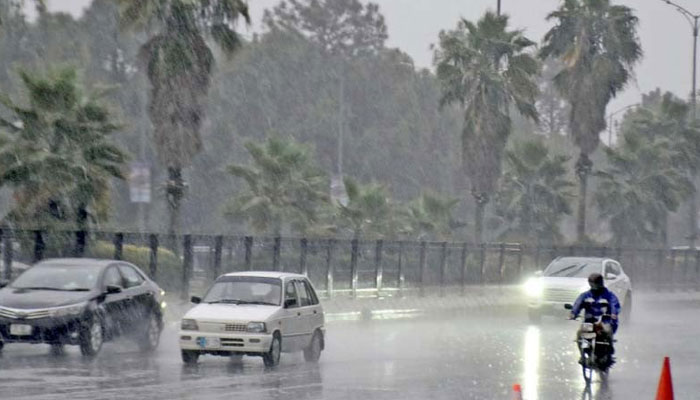Lahore gets ‘first-ever artificial rain’ to clear smog
Lahore was gripped by heavy smog turning it into a “poisonous gas chamber” where citizens continue to face serious health problems during the past several months
LAHORE: In an attempt to bring the Air Quality Index (AQI) down from a hazardous level, artificial rain was managed in parts of Lahore by the authorities on Friday.
This was the first time that rain was managed through cloud seeding in the provincial capital to clear the smog. Lahore has been gripped by heavy smog turning it into a “poisonous gas chamber” where citizens continue to face serious health problems during the past several months.
Lahore is often ranked one of the worst places globally for air pollution.
“Teams from the UAE, along with two planes, arrived here about 10 to 12 days ago. They used 48 flares to create the rain,” said caretaker Chief Minister of Punjab, Mohsin Naqvi.
Naqvi said that they planned to seed the clouds to trigger rains in 10 to 15 kilometre diameter of the provincial capital.
Water and Sanitation Agency officials said light rain fell in almost 10 areas, including Jail Road, Airport, Gulberg, Lakshami Chowk, Upper Mall, Mughalpura, Pani Wala Talab, Farkhabad and Qurtaba Chowk.
The interim chief minister said that most parts of Lahore received light rain, adding that clouds were generated around Shahdara and Muridke.
Giving details, Naqvi said the United Arab Emirates (UAE) provided funds for the artificial rain, adding that it cost the national exchequer just water expenses.
The chemicals in clouds were sprinkled with the help of two aircraft of the UAE government, he said.
CM Naqvi said they were looking at the results of artificial rain, adding that smog towers would be installed in the city soon.
When asked about long-term strategy to combat smog, the chief minister said the government needs studies to formulate a plan.
Pakistan Meteorological Department (PMD) officials said a mixture of silver iodide and common salt (sodium chloride) was used for causing artificial rain, which caused around 1mm or less rain in different areas as clouds had little potential to cause significant rain,
“Clouds over Lahore had very low potential to cause any significant amount of rain but the UAE-based company decided to go ahead with seeding to cause rain over Lahore. Hardly 1mm of rain or drizzle was reported in different areas of Lahore through this effort,” Chaudhry Aslam, Chief Met, Punjab, told The News.
He said a mixture of silver iodide and sodium chloride or common salt was sprinkled over clouds through an aircraft to cause rain artificially. “It is an effective method for rain augmentation provided clouds have enough potential to cause rain.”
Chaudhry Aslam maintained that they had given the time between 12 noon till 5 in the evening for seeding to cause the rain and added that this operation was done in coordination with the Lahore office of Pakistan Meteorological Department.
To a query, he said effects of artificial rain would be known today (Sunday) but feared that a light rain or drizzle would have little impact on quality of air and environment in the days to come. The PMD official said the UAE-based company used flares to sprinkle chemicals over the clouds, which made the droplets heavier and it rained under the influence of seeding.
Responding to a query, he said both India and China were regularly using their locally developed technology to cause rains over their cities whenever there are heavy clouds. In the Gulf, the UAE is increasingly using cloud seeding, sometimes referred to as artificial rain or blueskying, to create rain in the arid expanse of the country.
According to AFP, air pollution has worsened in Pakistan in recent years, as a mixture of low-grade diesel fumes, smoke from seasonal crop burn off and colder winter temperatures coalesce into stagnant clouds of smog.
Lahore suffers the most from the toxic smog, choking the lungs of more than 11 million residents in the Punjab’s biggest city during the winter season.
Levels of PM2.5 pollutants -- cancer-causing microparticles that enter the bloodstream through the lungs -- were measured as hazardous in Lahore on Saturday at more than 66 times the World Health Organisation’s danger limits.
Breathing the poisonous air has catastrophic health consequences.
Prolonged exposure can trigger strokes, heart disease, lung cancer and respiratory diseases, according to the WHO.
Successive governments have used various methods to reduce air pollution in Lahore, including spraying water on the roads, and weekend shutdowns of schools, factories and markets, with little or no success.
In 2000, an artificial rain experiment was carried out in Khuzdar, Balochistan; Chorr, Umerkot, Sindh; and near Murree after a severe drought from 1998.
“It was the first experiment and it did not produce the desired results,” said Sardar Sarfraz, Sindh Chief Met who supervised the artificial rain experiment in Khuzdar area of Balochistan.
-
 Gabriel Diallo Vs Alexander Zverev: Rising Canadian Eyes Major Upset Opportunity
Gabriel Diallo Vs Alexander Zverev: Rising Canadian Eyes Major Upset Opportunity -
 Bo Nix Injury Update: Broncos Quarterback Fractures Ankle Against Bills
Bo Nix Injury Update: Broncos Quarterback Fractures Ankle Against Bills -
 Oilers Vs Canucks: Why Edmonton Is Without Leon Draisaitl
Oilers Vs Canucks: Why Edmonton Is Without Leon Draisaitl -
 49ers Crushed As Kenneth Walker III Leads Seahawks To 41-6 Win
49ers Crushed As Kenneth Walker III Leads Seahawks To 41-6 Win -
 Canadiens Star Lane Hutson Makes History With 100th NHL Assist
Canadiens Star Lane Hutson Makes History With 100th NHL Assist -
 Bridgerton’s Claudia Jessie Says Her Real-life Style Is Nothing Like Eloise’s
Bridgerton’s Claudia Jessie Says Her Real-life Style Is Nothing Like Eloise’s -
 Prince William Barred From Riding E-scooter At His Own Home!
Prince William Barred From Riding E-scooter At His Own Home! -
 Prince William New PR Step Is Not 'shrewed Move,' Says Expert
Prince William New PR Step Is Not 'shrewed Move,' Says Expert -
 Barack Obama Honours Michelle Obama On Her 62nd Birthday
Barack Obama Honours Michelle Obama On Her 62nd Birthday -
 Why Kate Middleton Runs Away From 'some Royal Relatives'
Why Kate Middleton Runs Away From 'some Royal Relatives' -
 Khloe Kardashian's Ex-husband Lamar Odom Arrested In Las Vegas
Khloe Kardashian's Ex-husband Lamar Odom Arrested In Las Vegas -
 Andrew Mountbatten Windsor Has Staff From 'big Brother' For All His Needs
Andrew Mountbatten Windsor Has Staff From 'big Brother' For All His Needs -
 Perrie Edwards And Alex Oxlade-Chamberlain Welcome Second Child
Perrie Edwards And Alex Oxlade-Chamberlain Welcome Second Child -
 Meryl Streep To Return In 'Mamma Mia 3'?
Meryl Streep To Return In 'Mamma Mia 3'? -
 James Cameron Weighs In On Debates He Still Has About 'Titanic' Raft Scene
James Cameron Weighs In On Debates He Still Has About 'Titanic' Raft Scene -
 'Star Wars' Director Speaks Out Against 'scared' Comment
'Star Wars' Director Speaks Out Against 'scared' Comment




